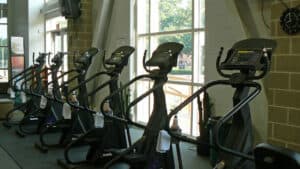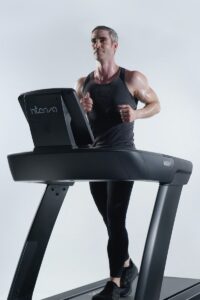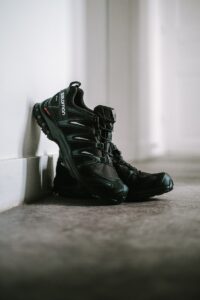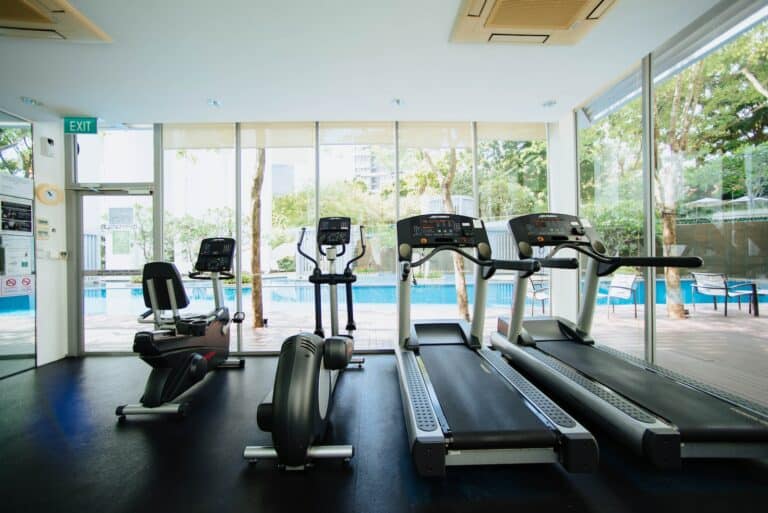Certainly, an intriguing question crosses the minds of trail runners and fitness enthusiasts alike: can you wear trail running shoes on a treadmill? The answer is yes, you can, but there are some factors to consider when wearing trail running shoes for treadmill workouts.
This article will discuss the differences between trail running shoes and other running shoes, the potential benefits and drawbacks of wearing trail shoes on a treadmill, and how to choose the best shoes for your workout needs.

Can You Wear Trail Running Shoes on a Treadmill: The Key Differences Between Trail Running Shoes and Other Running Shoes
Now, your question of whether can you wear trail running shoes on a treadmill has been answered, let’s dig deeper. Trail running shoes are designed specifically for off-road running, where terrain can be muddy and uneven surfaces are common. To better handle these challenges, most trail shoes have a few key differences compared to road running shoes. These differences include:
1. Traction: Many trail shoes have more aggressive tread patterns on their soles to provide a better grip on muddy and uneven surfaces.
2. Protection: Most trail running shoes offer more protection around the toes and underfoot than road shoes, in the form of reinforced materials or thicker soles. This helps to prevent injuries from rocks, roots, and other hazards found on trail runs.
3. Stability: Due to the uneven nature of trails, many trail shoes are designed with wider bases for better stability and support on uneven surfaces.
4. Weight: Trail running shoes can be heavier than road running shoes, as they need to provide the additional protection and traction mentioned above.
Can You Wear Trail Running Shoes on a Treadmill: Benefits & Drawbacks
Benefits of Wearing Trail Running Shoes on a Treadmill

So, now that we know the differences between trail shoes and other running shoes, what are the benefits of wearing trail running shoes on a treadmill? Here are a few advantages:
1. Versatility: If you don’t want to invest in separate shoes for both treadmill running and trail running, using your trail shoes for both can save you some money in the long run. As mentioned earlier, most trail running shoes can be used on a treadmill without any issues.
2. Protection: The additional protection offered by trail running shoes might come in handy for those with sensitive or injury-prone feet, even on the smooth surface of a treadmill belt.
3. Traction: If your treadmill belt gets wet from sweating, trail running shoe traction can help you maintain your footing and avoid slipping during your workout.
Drawbacks of Wearing Trail Running Shoes on a Treadmill

Can you wear trail running shoes on a treadmill? Of course yes but there are also some downsides to consider when it comes to wearing trail shoes on a treadmill. These include:
1. Weight: The heavier weight of most trail running shoes might not be ideal for treadmill running, whereas lighter road shoes are generally preferred for more efficient and faster workouts.
When it comes to running on a treadmill, the weight and design of your shoes can make a difference in terms of comfort and performance. While trail running shoes are designed to provide stability, traction, and protection on rugged terrain, they tend to be heavier and may not be the most suitable choice for treadmill running.
On the other hand, road running shoes are typically lighter and more streamlined, focusing on providing cushioning and responsiveness for efficient running on smooth surfaces like roads or treadmills. Lighter shoes can help reduce fatigue and enable faster workouts, as they require less energy to lift and move.
However, it’s important to note that individual preferences can vary. Some people may still prefer the added stability and support of trail running shoes, even on a treadmill. Additionally, if you plan to use the same pair of shoes for both trail running and treadmill running, you might prioritize the features that are most important to you or find a middle ground with a versatile shoe option.
2. Excess Tread: The aggressive tread on many trail shoes can cause increased wear on the treadmill belt, leading to more frequent maintenance and replacements.
The aggressive tread patterns found on many trail running shoes can indeed cause increased wear on treadmill belts. The rugged and deep lugs of trail shoes, which are designed to provide traction on uneven terrain, can be more abrasive to the smoother surface of a treadmill belt compared to the gentler tread patterns of road running shoes.
The aggressive lugs on trail shoes can create more friction and put additional stress on the treadmill belt, potentially leading to faster wear and tear. This can result in the need for more frequent maintenance and belt replacements, which can be costly and time-consuming.
If you primarily run on a treadmill, it is generally recommended to use shoes with less aggressive tread patterns, such as road running shoes. These shoes are designed to provide traction on smooth surfaces like roads and treadmills without causing excessive wear to the treadmill belt. They often have a flatter and more even outsole, which reduces friction and prolongs the lifespan of the treadmill belt.
3. Reduced Cushioning: Many trail shoes prioritize protection over cushioning. For some runners, this might lead to less comfortable treadmill workouts compared to using running shoes designed specifically for treadmill or road use.
Trail running shoes are typically designed to prioritize protection and stability on uneven and rocky terrains, which means they often have less cushioning compared to shoes specifically designed for treadmill or road use. The reduced cushioning in trail shoes may result in less comfort during treadmill workouts, especially if you’re accustomed to the cushioning provided by road running shoes.
Treadmill running involves repetitive impacts on a relatively hard surface, and having adequate cushioning can help absorb some of the shock and reduce the strain on your joints and muscles. Shoes designed specifically for treadmill or road use often have more cushioning in the midsole to provide a softer and more comfortable landing.
If you find that your trail running shoes lack sufficient cushioning for treadmill workouts and it affects your comfort level, you might consider using shoes with more cushioning specifically designed for road or treadmill running. These shoes are typically engineered to provide a balance of cushioning and responsiveness to enhance your running experience on smoother surfaces.
How to Choose the Best Trail Running Shoes for Treadmill and Trail Use

If you decide to wear trail running shoes on a treadmill, consider the following tips when choosing the best pair for your needs:
1. Look for lightweight trail shoes: To minimize the weight disadvantage of trail shoes while on a treadmill, go for lightweight trail shoes that don’t sacrifice too much protection and support.

2. Opt for less aggressive tread: While you still want good traction for both treadmill and trail running, choosing trail shoes with a slightly less aggressive tread can reduce the wear on your treadmill belt and provide a smoother running experience.
3. Consider cushioning: If your feet are sensitive or you prefer more cushioning during your workouts, look for trail running shoes with ample cushioning that still provide the necessary protection and traction.
The Verdict: Can You Wear Trail Running Shoes on a Treadmill?
So, can you wear trail running shoes on a treadmill? The answer is yes, you can wear trail running shoes on a treadmill. However, you’ll want to balance the benefits of trail shoe versatility, protection, and traction with the potential drawbacks of their weight, excess tread, and reduced cushioning. By carefully choosing your shoes and considering your workout needs, both on and off the treadmill, you can find the perfect balance of trail running and treadmill running shoes. So, don’t be afraid to give your trail runners a try on the treadmill – just be mindful of the differences and adjust your workout accordingly.
